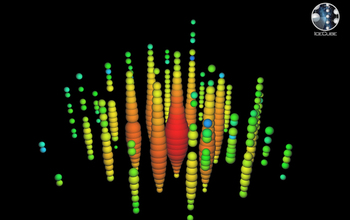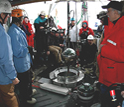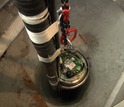News Release 13-194
NSF-funded IceCube Neutrino Observatory provides first indication of high-energy neutrinos from outside the solar system
Findings push neutrinos to the forefront of astronomy

A graphic representation of the highest energy neutrino ever observed.
November 21, 2013
For B-roll of the IceCube Neutrino Observatory and the Amundsen-Scott South Pole station, contact Dena Headlee, dheadlee@nsf.gov / (703) 292-7739.
This material is available primarily for archival purposes. Telephone numbers or other contact information may be out of date; please see current contact information at media contacts.
Researchers with the IceCube Collaboration have announced that a National Science Foundation (NSF)-built detector at the South Pole allowed them to observe 28 very high-energy neutrinos that constitute the first solid evidence for astrophysical neutrinos from cosmic accelerators."This is the first indication of high-energy neutrinos coming from outside our solar system," says Francis Halzen, principal investigator of IceCube and the Hilldale and Gregory Breit Distinguished Professor of Physics at the University of Wisconsin-Madison. "It is gratifying to finally see what we have been looking for. This is the dawn of a new age of astronomy."
Details of the research are in the Nov. 22 edition of the journal Science.
The IceCube Collaboration made the discovery using the IceCube Neutrino Observatory, a particle detector buried in Antarctic ice at the U.S. Amundsen-Scott South Pole Station. NSF built the detector using a Major Research Equipment and Facilities Construction (MREFC) award, with assistance from partner funding agencies around the world. Officials in NSF's Polar Programs and Physics divisions manage the observatory's operations, as well as the U.S. portion of the IceCube science research projects.
NSF's Division of Polar Programs has a presidential mandate to manage the U.S. Antarctic Program, through which it coordinates all U.S. research on the Southernmost continent and aboard ships in the Southern Ocean and provides all of the logistics needed to support that science.
"IceCube is a wonderful and unique astrophysical telescope. It is deployed deep in the Antarctic ice (from 1.4 to 2.4 km depth), but looks over the entire universe, detecting neutrinos coming through the Earth from the Northern skies, as well as from around the Southern skies," said Vladimir Papitashvili, Antarctic astrophysics and geospace science program director.
Added Jim Whitmore, program director on the particle astrophysics program, "The IceCube Neutrino Observatory has opened a new era in neutrino astrophysical observations. It is in the forefront of the entire field of neutrino astronomy, now delivering observations that have been long-awaited by both theorists and experimentalists."
Because they rarely interact with matter, neutrinos, nearly mass-less subatomic particles, can carry information about the workings of the highest-energy and most distant phenomena in the universe. Billions of neutrinos pass through the Earth every second, but the vast majority originate either in the sun, due to its internal thermonuclear process, or in Earth's atmosphere as a product of cosmic rays interacting with air molecules and ions.
Far rarer are neutrinos from the outer reaches of the Milky Way or beyond, which have long been theorized to provide insights into the powerful cosmic objects where high-energy cosmic rays may originate: supernovae, black holes, pulsars, active galactic nuclei and other extreme extragalactic phenomena.
IceCube, run by the international IceCube Collaboration and headquartered at the Wisconsin IceCube Particle Astrophysics Center (WIPAC) at University of Wisconsin-Madison, was designed to accomplish two major scientific goals: measure the flux, or rate, of high-energy neutrinos and identify, if possible, their sources.
The analysis published in Science reveals the first high-energy neutrino flux ever observed--a highly statistically significant signal that meets expectations for neutrinos originating in cosmic accelerators.
"From hints in earlier research results by IceCube collaborators, we have used improved data-analysis methods and explored more data to make this significant step forward in our search for the elusive astrophysical signal,” said collaboration spokesperson Olga Botner, of Uppsala University. “We are now working hard on improving the significance of our observation and on understanding what this signal means and where it comes from."
The 28 high-energy neutrinos were found in data collected by the IceCube detector from May 2010 to May 2012. The data could not be explained by other neutrino fluxes, such as those from atmospheric neutrinos, nor by other high-energy events, such as muons produced by the interaction of cosmic rays in the atmosphere.
Preliminary results of this analysis were presented May 15, 2013 at the IceCube Particle Astrophysics Symposium at the University of Wisconsin.
"Now that we have the full detector we have the sensitivity to see these events. After seeing hundreds of thousands of atmospheric neutrinos, we have finally found something different," Halzen explained. "We've been waiting for this for so long."
IceCube comprises 5,160 digital optical modules suspended along 86 strings embedded in a cubic kilometer of ice at the geographic South Pole, and an additional 344 IceTop modules, a complementary detector on the surface of the ice, needed to screen out events caused by cosmic rays' interaction with the Earth's atmosphere. The observatory detects neutrinos through tiny flashes of blue light, called Cherenkov light, produced when neutrinos interact in the ice.
The IceCube detector was completed in December 2010 after seven years of construction that only could be carried out during the very short Antarctic summer, a period of roughly 90 days. It was built on time and within budget, and in its first three years of performance has exceeded its design specifications.
"The success of IceCube builds on the efforts of hundreds of people around the world," noted Botner. "IceCube collaborators made it all happen--from the design and the deployment in a harsh environment, proving the feasibility of the concept, to data harvesting and physics analysis. All required concerted efforts that ultimately have led to the observations presented in this paper. Now the collaboration is addressing a further challenge: How to make IceCube a big contributor to astronomy."
The University of Wisconsin-Madison is the lead U.S. IceCube institution, and the international collaboration includes 250 physicists and engineers from the United States, Germany, Sweden, Belgium, Switzerland, Japan, Canada, New Zealand, Australia and the United Kingdom.
-NSF-
-
IceCube is the world's largest neutrino detector.
Credit and Larger Version -
View Video
Footage of the IceCube Neutrino Observatory.
Credit and Larger Version
Media Contacts
Peter West, NSF, (703) 292-7530, email: pwest@nsf.gov
Program Contacts
Vladimir Papitashvili, NSF, (703) 292-7425, email: vpapita@nsf.gov
James Whitmore, NSF, (703) 292-8908, email: jwhitmor@nsf.gov
Related Websites
A gallery of media related to this discovery, compiled by the Wisconsin IceCube Particle Astrophysics Center (WIPAC).: icecube.wisc.edu/press/gallery
Watch a video, produced by Science Nation, NSF's on-line video news magazine, about IceCube.: http://www.nsf.gov/news/mmg/mmg_disp.cfm?med_id=73275
Remarks given by former NSF Director Subra Suresh, " IceCube: A New Kind of Observatory for a New Century of Antarctic Science".: http://www.nsf.gov/news/mmg/mmg_disp.cfm?med_id=69572
The U.S. National Science Foundation propels the nation forward by advancing fundamental research in all fields of science and engineering. NSF supports research and people by providing facilities, instruments and funding to support their ingenuity and sustain the U.S. as a global leader in research and innovation. With a fiscal year 2023 budget of $9.5 billion, NSF funds reach all 50 states through grants to nearly 2,000 colleges, universities and institutions. Each year, NSF receives more than 40,000 competitive proposals and makes about 11,000 new awards. Those awards include support for cooperative research with industry, Arctic and Antarctic research and operations, and U.S. participation in international scientific efforts.
Connect with us online
NSF website: nsf.gov
NSF News: nsf.gov/news
For News Media: nsf.gov/news/newsroom
Statistics: nsf.gov/statistics/
Awards database: nsf.gov/awardsearch/
Follow us on social
Twitter: twitter.com/NSF
Facebook: facebook.com/US.NSF
Instagram: instagram.com/nsfgov




